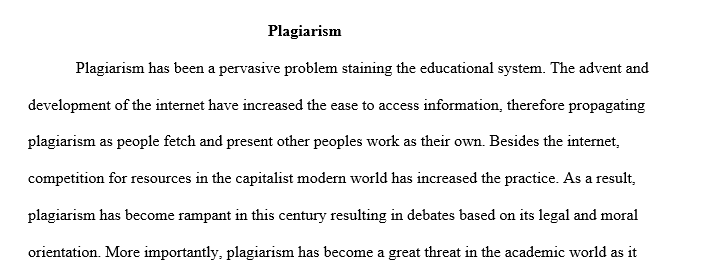Compare/Contrast Essay
Minimum word count: 1200 words
Required sources: 3
This paper has the most “weight” of any paper in the course and the longest word count requirement.
Closely follow instructions in the module and thoroughly edit your paper for past writing errors and feedback for each stage of the paper.
See handbook page 8 and 21 about compare and contrast writing.
See handbook 42 for more about a proposal argument under “Argument assignments.”
Main Goal:
Write an argumentative essay that presents a problem and then compares and contrasts two solutions to determine a logical resolution.
Sample Topics:
You may choose one of the topics below or propose your own topic for this major assignment.
- Body image: Does the media present unrealistic expectations? How can we raise self esteem?
- Bullying: What forms does it take? Who is responsible for addressing it–parents, teachers, administrators, students?
- Plagiarism: Why is it such a problem today? How can it be prevented?
- Privacy: Do we need it? Is it more important than security?
- Illegal immigration: Is this an economic or race issue? Should states or federal governments regulate?
- Social media: Is it addictive? Has it negatively impacted personal relationships and communication?
Sources:
With this paper, students are responsible for researching 3 credible source materials. At least 1 or more must come from the college library databases.
Requirements:
1. You must have at least 1200 words to earn a passing grade on this assignment. Minimum word count does not include the cover page, outline, heading, title, or Works Cited page of your paper. Please use Times News Roman 12-point or a comparable font.
2. You must have an MLA-style cover page and a formal outline. The cover page should contain a well-worded title or titles which capture the reader’s interest and move him or her to turn the page to read the essay. See more about effective titles in the Essay Basics section of the Writer’s Resources module.
3. You must have a clear and developed introductory paragraph that contains an argumentative thesis statement. See more about introductions in the Essay Basics section of the Writer’s Resources module.
4. You must have three or more body paragraphs unified by clear topic sentences and focused on proving the thesis through either the point-by-point or subject-by-subject organizational strategy. See more about body paragraphs in the Essay Basics section of the Writer’s Resources module.
5. You must incorporate material from a minimum of 3 credible sources. Any quotes, paraphrases, or summaries must be introduced and incorporated into your own sentences. They must include an in-text citation or acknowledgment in MLA format and a follow-up sentence that clearly relates the material to your own argument. Check past modules for more information about quoting from sources and avoiding plagiarism.
6. You must have a conclusion that brings closure to your entire essay. See more about conclusions in the Essay Basics section of the Writer’s Resources module.
7. You must include a Works Cited page as the last page of the document. This page must be in MLA format. See past paper modules for more about the works cited.
8. You must submit your final paper to the Compare/Contrast Essay Dropbox.
Common Errors:
1. Avoid first person (I, me, my, mine, we) and second person (you, your, and understood “you” commands) as well as contractions. This type of wording is considered informal unless it appears in a quote from a source. Hint: Reading your paper aloud can help you spot informal wording. See more about common errors to avoid in the Academic Language item in the Grammar Basics section of Writer’s Resources module.
2. Avoid comma splices and fragments. These errors are major issues that will result in a significant reduction of points. Edit each sentence individually to avoid them. See more about these major errors and how to avoid them in the Grammar Basics section of the Writer’s Resources module.
3. Avoid subject-verb and pronoun antecedent agreement errors through careful editing. These errors can be difficult to locate because they are often found in our speech. Pay careful attention. See more about these major errors and how to avoid them in the Grammar Basics section of the Writer’s Resources module.
4. Avoid dumped quotes. This is when borrowed materials lack a lead-in or phrase of attribution to connect them to your own argument. Also, remember to follow up on any borrowed materials. See quoting examples in past paper modules. Avoid errors you have made on past papers.
Writing Tips:
1. Make sure that your paper establishes a legitimate problem, presents two potential solutions, and effectively argues for the more reasonable solution.
2. Make sure your paper follows one of the compare/contrast organizational strategies: point-by-point or subject-by-subject. Also, consider transitions as you organize. You want your reader to see the connections between your points.
3. Be sensitive to your audience as you consider your tone and language. If you feel there is a point of contention, acknowledging it and then explaining your point of view can be a helpful way to address this. Reading out loud can also increase your audience awareness because it allows you to hear your arguments in a more objective way.
4. Make sure your argument avoids logic fallacies. See more about logic fallacies in the module or click direct link Logic Fallacies.
5. Thoroughly review the Four Pitfalls of Comparison/Contrast Writing and eliminate them from your own paper. See this item in Content, or click here to open in a new window: Four Pitfalls.
1298 Words
MLA
